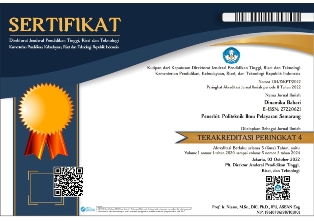Peranan Alat Navigasi di Kapal Untuk Meningkatkan Keselamatan Pelayaran di Atas Kapal
Abstract
The guard rules that have been set by Collision Regulation 1972, STCW 1978 as amended in 2010 Regulation II / 1, all ships are obliged to carry out the guard duty without exception. As for the implementation, the duty officer must ensure that 1) All visual early warnings are taking place on the existing situation, including the presence of ships and signs from the land. 2) Continuous observation and bearing of approaching ships. 3) Identifying ships and land lights. 4) Checking the direction of the steering wheel and commanded steering signals. 5) Radar observation and echo sounder. 6) Observation of weather changes, especially visibility. This research uses a qualitative approach with descriptive delivery. The purpose of this study is to describe the role of navigation tools in increasing the level of shipping safety. With the results of this study, where an officer must optimize the operation and maintenance of navigation devices in order to carry out a proper observation. The use of navigation tools such as binoculars, radar, Automatic Identification System (AIS), and Electronic Charts Display and Identification System (ECDIS) is very helpful in optimizing existing observations. So improving skills in guard duty, especially in terms of making observations, must be as optimal as possible to take advantage of the help of navigation tools. Because observation is very important in order to avoid the danger of collision and achieve safety in shipping.
Downloads
References
Arfan, D. (2018). Peningkatan kemampuan perwira jaga fresh graduate dalam menggunakan alat-alat navigasi untuk mencegah bahaya tubrukan di mv. Energy midas (Doctoral dissertation, POLITEKNIK ILMU PELAYARAN SEMARANG). http://repository.pip-semarang.ac.id/587/6/13%20-%20BAB%202%20%2810-30%29.pdf
College, Old Aberdeen. EW. Manikome. (2008). Maritime English for Ship Officer.
He, Yixiong, et al. (2017). Quantitative Analysis of COLREG Rules and Seamanship for Autonomous Collision Avoidance at Open Sea. Ocean Engineering, 140 : 281-291
Hendrawan, A. (2019). Analisa Indikator Keselamatan Pelayaran pada Kapal Niaga. Saintara: Jurnal Ilmiah Ilmu-Ilmu Maritim, 3(2), 53-59.
Istopo. Peraturan International tentang Pencegahan Tubrukan di Laut 1972. Yayasan CAAIP.
Konvensi COLREG 1972 tentang Pengaturan Pencegahan Tubrukan Kapal di Laut
STCW 1978 as amended in 1995 Regulation II/1
Konvensi SOLAS 1974 tentang Keselamatan Penumpang dan Awak Kapal di Laut
Margono, S. (2005). Metodologi Penelitian Pendidikan. PT. Rineka Cipta.
Moleong, Lexy J. (2007). Metodologi Penelitian Kualitatif. PT. Remaja Rosdakarya.
Riduwan. (2003). Dasar-Dasar Statistik. Alfabeta
STCW ( standar Of Training Certification and Wachkeeping For Seaferer) (2010). Pada Chapter VIII. Berkaitan dengan Tugas Jaga.
Sugiyono. (2010). Metode Penelitian Pendidikan Pendekatan Kuantitatif, kualitatif, dan R&D. Alfabeta
Sugiyono. (2005). Metode Penelitian Kuantitatif Kualitatif dan R&D. Alfabeta
Hendrawan, A. (2019). Analisa Indikator Keselamatan Pelayaran Pada Kapal Niaga. Saintara: Jurnal Ilmiah Ilmu-Ilmu Maritim, 3(2), 53-59.
Triananda, A. (2016) Analisis Peran Dan Fungsi Navigasi Guna Mendukung Keamanan, Keselamatan Dan Kelancaran Pelayaran Berdasarkan Pasal 172 Sampai Dengan Pasal 177 Undang. Jurnal Hukum Prodi Ilmu Hukum Fakultas Hukum Untan (Sekripsi S1 Fakultas Hukum Universitas Tanjungpura).
Wahyuni, Eni Tri. (2019). Peranan Alat Navigasi Di Kapal Untuk Meningkatkan Keselamatan Pelayaran Di Atas Kapal. Proceeding of 1st National Seminar on interdesciplinary Studies. Politeknik Bumi Akpelni: Semarang. Published 2019-08-13. p. 269 – 274. https://e-journal.akpelni.ac.id/index.php/prosiding/article/view/92














